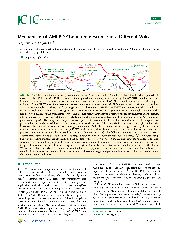摘要
The chemiluminescence phenomenon of 3-(2'-spiroadamantyl)-4-methoxy-4-(3 ''-phosphoryloxy)-phenyl-1,2-dioxetane (AMPPD or m-AMPPD) has been routinely applied in clinical diagnostics. Although the AMPDD chemiluminescence immunoassay is one of the most successful immunoassays, the mechanism of AMPPD chemiluminescence remains largely unknown. The AMPPD chemiluminescence process is composed of three steps: AMPPD is enzymatically triggered to produce 3-(2'-spiroadamantyl)-4-methoxy-4-(3 ''-hydroxyphenyl)-1,2-dioxetane (m-AMPD); m-AMPD decomposes into the excited-state methyl m-oxybenzoate anion (m-MOB-); the excited-state m-MOB- relaxes to its ground state and emits light. Obviously, the middle step is critical for the chemiluminescence and has not been well understood because of both experimental and theoretical difficulties. We performed the first theoretical study on the chemiluminescent decomposition mechanism of m-AMPD and its para isomer, p-AMPD, using the complete active space self consistent field and the second order multiconfigurational perturbation methods in addition to the density functional method. This investigation revealed that (1) neither the intramolecular chemical initiated electron exchange luminescence (CIEEL) nor the concerted charge transfer (CT) mechanism can describe the decomposition of m- and p-AMPD well Instead, their decomposition occurs according to our previously proposed mechanism of gradually reversible CT initiated luminescence. (2) The different stabilities of the m- and p-AMPD chemiexcited states might be the basis for the large difference in their chemiluminescence efficiencies. (3) The relationship between the chemiluminescence efficiency and the position of the electron donor on the aromatic ring, the so-called "odd/even selection rule," does not fully explain the chemiluminescence efficiency of dioxetanes. The odd/even selection rule is only correct for partial dioxetanes, because it does not capture the origin of the relationship between the chemiluminescence and the donor. We revealed that the origin consists of a combination of conjugation, induction, and steric effects. On the basis of this combination of effects, we theoretically designed some 1,2-dioxetanes to guide experimentalists in the synthesis of these excellent chemiluminescent molecules.
- 出版日期2013-5
- 单位北京师范大学
